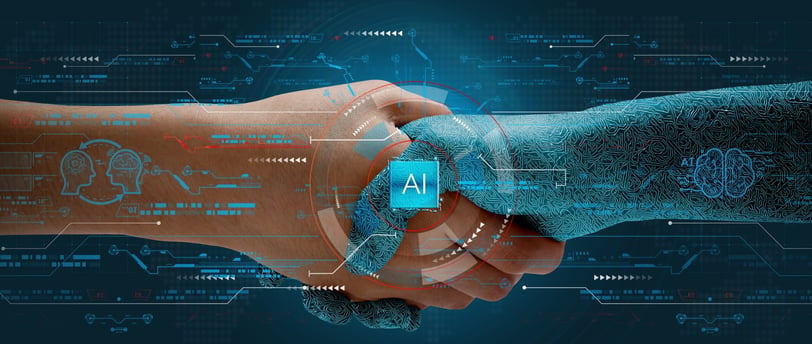The Role of Human-Technology Interaction
Enhancing Collaboration Between Humans and Machines
AI
12/8/20243 min read


The Role of Human-Technology Interaction: Enhancing Collaboration Between Humans and Machines
In today’s rapidly evolving digital landscape, human-technology interaction has become central to how we interact with the world. This partnership leverages human creativity and emotional intelligence alongside technological efficiency and precision, driving advancements across various industries. This article explores the dynamic relationship between humans and technology, highlighting real-world examples and insights for optimizing this interaction.
Understanding Human-Technology Interaction
Human-Technology Interaction (HTI) refers to the ways people engage with technology to achieve tasks, solve problems, and enhance experiences. It combines principles from psychology, computer science, and design to create user-friendly systems that amplify human capabilities.
For a deeper dive into the field, check out this introductory guide to Human-Technology Interaction.
How Humans and Technology Complement Each Other
Human Attributes:
• Creativity and Intuition: Humans excel at creative problem-solving and understanding context.
• Emotional Intelligence: The ability to empathize and build relationships remains uniquely human.
Technological Capabilities:
• Data Processing: Machines can analyze large datasets rapidly, uncovering patterns humans might miss. Learn more about data processing in AI.
• Automation: Technology performs repetitive tasks efficiently, reducing human error.
By combining these strengths, human-technology collaboration creates environments where both excel beyond individual capacities.
Real-World Examples of Human-Technology Interaction
1. Healthcare: AI-Assisted Diagnostics
AI is revolutionizing healthcare by assisting medical professionals with diagnosing diseases. Tools like Google DeepMind and IDx-DR analyze medical data, providing doctors with insights to detect conditions like cancer or diabetic retinopathy earlier.
• Example: Learn more about how AI is transforming healthcare.
2. Education: Personalized Learning Platforms
Platforms like Khan Academy and Duolingo use AI to personalize learning experiences, adapting to individual strengths and weaknesses for better outcomes.
• Example: Explore how AI in education is shaping the future.
3. Workplace Productivity: AI-Powered Tools
AI tools like Grammarly and Microsoft Copilot assist with tasks such as writing, scheduling, and summarizing, helping teams focus on higher-value activities.
• Example: Learn about more AI tools improve workplace productivity.
4. Autonomous Vehicles: AI in Transportation
Semi-autonomous vehicles like Tesla’s Autopilot use AI to assist with navigation and lane-keeping, but human oversight remains essential for complex driving scenarios.
• Example: Read more about the role of AI in autonomous vehicles.
5. Creative Industries: AI in Art and Design
AI tools like DALL-E and Adobe Sensei help artists generate ideas and streamline workflows, enabling them to focus on refining their creative vision.
• Example: See how AI is reshaping creative industries.
Benefits of Human-Technology Interaction
• Enhanced Decision-Making: AI provides data-driven insights, while humans bring context and judgment. Explore how AI supports decision-making.
• Improved Efficiency: Automating routine tasks allows humans to focus on creativity and strategy.
• Accessibility: Tools like AI translators break language barriers, making technology more inclusive.
• Innovation: Collaboration between humans and technology sparks new ideas and advancements.
Challenges in Human-Technology Interaction
Over-reliance on Technology: Excessive automation risks skill degradation. Humans must retain essential oversight to ensure balanced interaction.
Bias in AI Systems: Algorithms can reflect biases in their training data.
Privacy Concerns: With increasing integration of technology, concerns about data privacy and security grow.
Addressing these challenges requires ethical AI design, transparency, and active human involvement.
Optimizing Human-Technology Collaboration
1. Continuous Learning: Stay informed about emerging technologies through platforms like Coursera or LinkedIn Learning.
2. Ethical Design: Build technologies that prioritize fairness, transparency, and inclusivity.
3. User-Centered Development: Involve end-users in the design process for accessible and practical solutions.
4. Balanced Integration: Maintain equilibrium between automation and human control to preserve skills and oversight.
The interplay between humans and technology continues to shape industries, improve efficiency, and enhance quality of life. By leveraging each other’s strengths, we can achieve greater innovation and productivity. As this collaboration evolves, ethical considerations and continuous learning will be key to unlocking its full potential.
For more insights into human-technology interaction and the latest developments in AI and blockchain, visit block3ai.com/education.
Connect
Contact
Stay Up to Date
info@block3ai.com
© 2024. All rights reserved.
